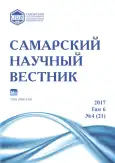Modeling of fungal mycelium growth by fourth-class continuous stochastic cellular automaton with continuously defined growth conditions
- Authors: Shumilov A.S.1, Blagodatsky S.A.1
-
Affiliations:
- Institute of Physicochemical and Biological Problems of Soil Science of Russian Academy of Sciences
- Issue: Vol 6, No 4 (2017)
- Pages: 98-102
- Section: 03.02.00 – General Biology
- URL: https://journals.rcsi.science/2309-4370/article/view/22279
- DOI: https://doi.org/10.17816/snv201764120
- ID: 22279
Cite item
Full Text
Abstract
The aim of this work was to simulate the growth and spatial structure of the fungal mycelium using a cellular automaton based on the synthesis of various model approaches. The spatial structure of the mycelium is described in the structural submodel of the cellular automaton, which determines the growth rate in the direction of larger resource amount and the number of branches of the mycelium per area unit. The amount of available substrate determines the probability of unidirectional apical growth. Another, biochemical part of the model allows us to describe the rate of transport of resources into the cell, their transport within the mycelium, and also their excretion, and is intended to describe the vertical and horizontal migration in the soil of two nutrients. The proposed model makes it possible to quantitatively describe such a feature of fungal colony growth as more active absorption of resources by external cells, compared to central ones due to separation of transport resources into active and passive resources. The active transport was described using the Michaelis-Menten kinetics. We were able to simulate the stockpiling of surplus resources and their redistribution over the mycelium after the exhaustion of reserves in the external environment, and also to simulate typical growth patterns of mycelial colonies that were observed in experiments published in the literature.
Keywords
Full Text
##article.viewOnOriginalSite##About the authors
Anatoliy Sergeevich Shumilov
Institute of Physicochemical and Biological Problems of Soil Science of Russian Academy of Sciences
Author for correspondence.
Email: anatoliy.sergreevich.shumilov@gmail.com
postgraduate student, junior researcher of Mathematical Modeling of Ecosystems Laboratory
Russian Federation, PushchinoSergey Alexandrovich Blagodatsky
Institute of Physicochemical and Biological Problems of Soil Science of Russian Academy of Sciences
Email: sblag@mail.ru
doctor of biological sciences, leading researcher of Soil Nitrogen and Carbon Cycles Laboratory
Russian Federation, PushchinoReferences
- Добровольский Г.В. Педосфера - оболочка жизни планеты Земля // Биосфера. 2009. Т. 1, № 1. С. 6-14.
- Dix N.J., Webster J. Fungal ecology. Springer-Science+Business Media, 1995. 549 p.
- Hofsten B.V., Rydéean A.L. Submerged cultivation of a thermotolerant basidiomycete on cereal flours and other substrates // Biotechnology and Bioengineering. 1975. Vol. 17 (8). P. 1183-1197.
- Alton L. The viability of microscopic fungal cultures from soddy-podzolic soil at different temperatures of sea and river water // Microbiology. Vol. 52. P. 482-485.
- Ritz K., Young I.M. Interactions between soil structure and fungi // Mycologist. 2004. Vol. 18 (2). P. 52-59.
- Jacobs H., et al. Solubilization of calcium phosphate as a consequence of carbon translocation by Rhizoctonia solani // FEMS Microbiology Ecology. 2002. Vol. 40 (1). P. 65-71.
- Boswell G.P. Modelling mycelial networks in structured environments // Mycological research. 2008. Vol. 112 (9). P. 1015-1025.
- Boswell G.P., Hopkins S. Linking hyphal growth to colony dynamics: spatially explicit models of mycelia // Fungal Ecology. 2008. № 1 (4). P. 143-154.
- Regalado C.M., Sleeman B.D., Ritz K. Aggregation and collapse of fungal wall vesicles in hyphal tips: a model for the origin of the Spitzenkörper // Philosophical Transactions of the Royal Society of London B: Biological Sciences. 1997. Vol. 352 (1364). P. 1963-1974.
- Szabo R., Štofanı́ková V. Presence of organic sources of nitrogen is critical for filament formation and pH-dependent morphogenesis in Yarrowia lipolytica // FEMS microbiology letters. 2002. Vol. 206 (1). P. 45-50.
- Gbolagade J., et al. Effect of physico-chemical factors and semi-synthetic media on vegetative growth of Lentinus subnudus (Berk.), an edible mushroom from Nigeria // Food chemistry. 2006. Vol. 99 (4). P. 742-747.
- Вигонт В.А., Миронычева Е.С., Топаж А.Г. Модификация модели роста грибов Чантера-Торнли и ее анализ средствами многоподходного имитационного моделирования // Компьютерные исследования и моделирование. 2015. № 7 (2). С. 375-385.
- Stadler D.R. Chemotropism in Rhizopus nigricans: the staling reaction // Journal of Cellular and Comparative Physiology. 1952. Vol. 39 (3). P. 449-474.
- Meyer A., et al. Simulating mycorrhiza contribution to forest C-and N cycling-the Mycofon model // Plant and soil. 2010. Vol. 327 (1-2). P. 493-517.
- Семенов А.Я., Абрамова Л.П., Хохряков М.К. Определитель паразитных грибов на плодах и семенах культурных растений. Л.: Колос: Ленингр. отд-ние, 1980. 302 с.
- Сычёв П.А., Ткаченко Н.П. Грибы и грибоводство. М.: АСТ-Сталкер, 2003. 511 с.
- Davidson F.A. Mathematical modelling of mycelia: a question of scale // Fungal Biology Reviews, 2007. № 21 (1). P. 30-41.
- Кураков А.В., Харин С.А. Взаимодействия грибов и дождевых червей // Биотические связи грибов: мосты между царствами: мат-лы VII всерос. микологической школы-конф. с междунар. уч. М.: МГУ, 2015. С. 67-105.
- Федоровская Г.И. Грибная энциклопедия. М.: Рипол-Классик, 2002. 574 с.
- Ryan F.J., Beadle G., Tatum E. The tube method of measuring the growth rate of Neurospora // American Journal of Botany. 1943. P. 784-799.
- Madkour S., et al. Effect of treatment with industrial waste water on the growth and pathogenicity of some soil-borne fungi // Journal of Agricultural Sciences Mansoura University. 1991. Vol. 16, 3. P. 598-614.
- Gow N., et al. The fungal colony // Cambridge University Press 2007. Vol. 21.
- Горбунова И.А. Макромицеты Приобских боров // Сибирский ботанический вестник. 2007. № 2 (1). С. 41-50.
- Ritz K. Growth responses of some soil fungi to spatially heterogeneous nutrients // FEMS Microbiology Ecology. 1995. Vol. 16 (4). P. 269-279.
- Ames R., et al. Hyphal uptake and transport of nitrogen from two 15N-labelled sources by Glomus mosseae, a vesicular-arbuscular mycorrhizal fungus // New Phytologist. 1983. Vol. 95 (3). P. 381-396.
- Kaiser C., et al. Microbial community dynamics alleviate stoichiometric constraints during litter decay // Ecology letters. 2014. Vol. 17 (6). P. 680-690.
Supplementary files









